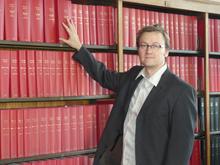Title: The allure of linearity: Exploring the link between strange metallicity and high-temperature superconductivity
Speaker: Nigel Hussey
Time: Oct. 26th (Thu.), 20:00
Zoom ID: 885 1517 9800
Abstract:
In typical metals, the electrical resistivity ρ tends to vanish at the extreme f temperature T and magnetic field strength H, albeit for different reasons. At intermediate temperatures, however, ρ(T) is invariably linear due to the scattering of electrons off phonons – the quantized vibrations of the lattice. Electronphonon coupling is also responsible for superconductivity in many of these metals. Indeed, a robust correlation exists between the coefficient of the T-linear resistivity α and the superconducting transition temperature Tc; a link enshrined in the old adage “bad metals make good superconductors”.
Despite being discovered almost four decades ago, the high-Tc cuprates still boast the highest ambientpressure Tc values of all known materials. Intriguingly, a similar correlation between α and Tc exists in cuprates too, prompting many in the field to argue that whatever is the cause of this (T-linear) scattering is also the pairing mechanism for high-temperature superconductivity. Despite a prolonged and intense
search, however, the origin of this scattering has not been identified. Crucially, the linearity in ρ in cuprates extends over an anomalously broad temperature and field range, implying an unconventional electronic state. Moreover, the H-linear resistivity has a slope ϒ that also correlates with Tc. In this colloquium, I will discuss the profound implications of these correlations, along with a number of other simple observations linking the (magneto)transport properties of cuprates with their corresponding superconducting properties. Collectively, these observations motivate the search for an entirely new paradigm for hightemperature superconductivity, one in which these T- and H-linearities play a central role.
Bio:

Nigel Hussey has been full professor since 2006, initially at the University of Bristol then from 2013 at Radboud University. From 2013 until 2018, he also served as director of the High Field Magnet Laboratory. His research focuses on precision measurements of the transport properties of exotic, low-dimensional metals and superconductors in high magnetic fields. He is credited with the first experimental determination of the full Fermi surface of a high temperature superconductor, and the discovery of the strange metallic state. In recognition of these discoveries, he has been a recipient of the Charles Vernon Boys medal (now the Henry Moseley medal) from the Institute of Physics, the inaugural Brian Pippard superconductivity prize and a Royal Society Wolfson Research Merit award. He is also an elected Fellow of the Institute of Physics. In 2019, Hussey received an ERC Advanced grant.




